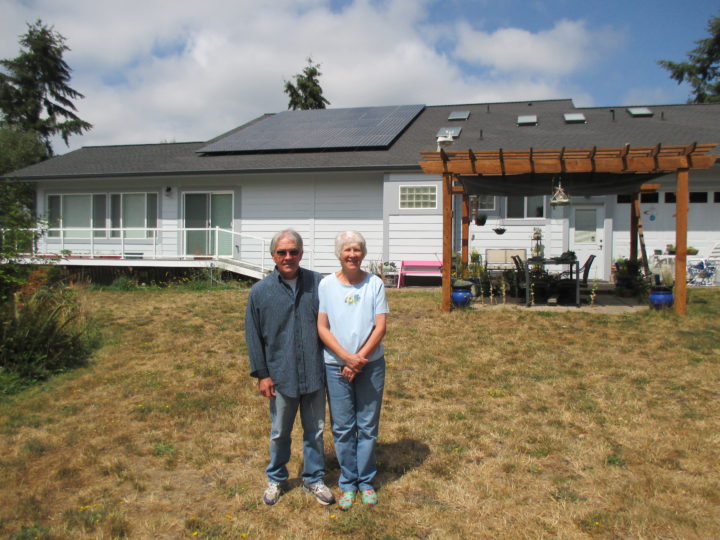On Jan 10th we were surprised to receive a letter from Clallam PUD indicating that on January 8th, the PUD Board of Commissioners resolved to discontinue retail net metering as of February 1st. This action appears to have been taken without notice nor with request for input comment from the public, and the resolution does not appear to be on the agenda for the meeting. http://powertripenergy.com/wp-content/uploads/1-8-18-Commissioners-PreAgenda-FINAL-1.pdf
This means the utility will still allow interconnection of your clean safe solar, but will now be crediting a portion of the solar produced electricity at their claimed wholesale cost rather than crediting solar generators the same rate they charge customers per kilowatt hour (kwh), which is what is referred to as net metering. So for the portion above and beyond a home’s usage during the summer months, the homeowner will be credited at about 3.5 cents / kwh rather than 7 cents / kwh. Existing Net Metering customers will retain their current agreement. This will affect all new Clallam PUD interconnections as of Feb 1st.
The legal basis for this is that the RCW 80.60 only requires that utilities allow net metering in an amount of 0.5% of the 1996 peak loads (the net metering law was passed in 1998.) There is no technical nor economic basis for this threshold, which is much lower than most other states; it is just a relic of the flawed legislative process of the time. This amount has now been exceeded in Clallam PUD so they currently have the legal option to close down new net metering applications, which the commissioners have decided to exercise.
There is currently a bill being considered in Olympia (SB 6081) which would remedy this situation state-wide, and update our 20 year old Net Metering law.
There are three courses of action we currently recommend:
1. If you have been considering installing grid-tied solar pv, order your system now so we can submit your application prior to January 31st, and install your system before this summer.
3. Support Senate Bill 6081, which is currently being considered by the state legislature, and which would eliminate this archaic limitation to the net metering requirements. Learn more here:
http://solarstrongwa.org/
Here are the documents we received on Jan 10th. We currently have no minutes for the Jan 8th meeting nor any record of what was discussed or what basis was used for making this decision.
by Andy Cochrane | Jan 17, 2018
Last month in Bellevue, leaders in the state’s solar industry gathered along with legislators, regulators, and solar advocates for the annual Washington Solar Summit. This year was notable for several reasons including much discussion of the transition from the legacy incentive program to the new and improved incentive program, a review of the status of net metering across the 60+ utility territories in Washington state, and a keynote speech from Gov Inslee, a supporter of renewable energy during his entire political career.
The state’s small-scale renewable energy incentive program, originally passed in 2005, has been successful in raising awareness, and recognizing the benefits of distributed generation, but had reached the end of its useful life as a program due to its 2020 sunset date. The new incentive program will provide certainty for another few years while keeping the state’s overall investment low and making sure the state is getting the best results for its support of the industry. The downside to the new program is that it appears the overall caps are low enough that the local solar industry will experience two very busy years until the program closes. When programs open and close and dramatically affect demand suddenly, it presents a challenge to businesses that serve that market. We are happy to forecast however that the new program could result in an additional 100 solar homes each in Jefferson and Clallam Counties in the next two years.
While the state’s new incentive programs are encouraging another wave of distributed solar installations, the state’s net metering law is outdated and does not provide the necessary support for the potential new projects which have now been incentivized. Updating the state’s Net Energy Metering laws is the most important issue the solar industry faces, and with over 60 utilities statewide now left to develop their own policies, the utility industry would also benefit from stronger state guidance.
Gov. Inslee spoke about the importance of renewable energy from a climate change perspective, but also highlighted the economic benefits to the state of being a leader in clean energy, in terms of jobs and high tech facilities like the REC Silicon facility in Moses Lake. While federal policy remains unpredictable, at the state level, Gov Inslee has provided leadership on this issue through partnership with several other states in the United States Climate Alliance. More information is available here: https://en.wikipedia.org/wiki/United_States_Climate_Alliance
With the brief moment in which I had the Governor’s ear, I expressed support for carbon pricing as a way to achieve greenhouse gas reduction targets. It makes economic sense to me to tax things we wish to discourage, like carbon emissions, rather than taxing things we want to encourage, like individual income and home ownership.
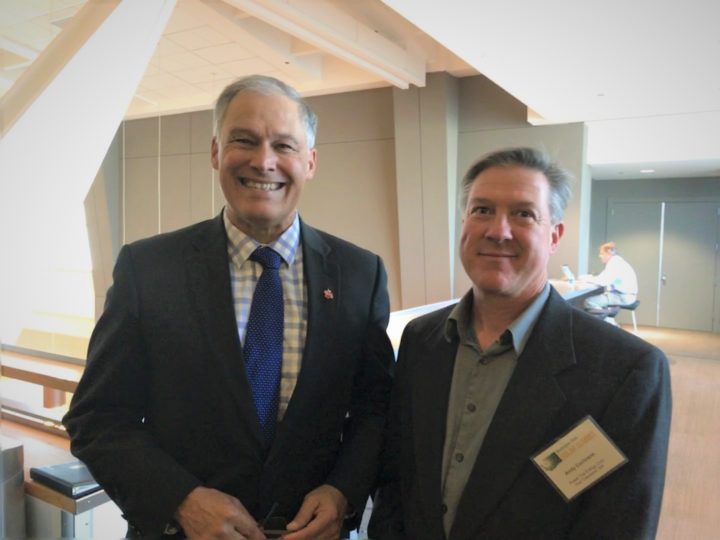
by Andy Cochrane | Nov 21, 2017
Solar Agent
Be an agent of solar change and help clients navigate their choices to determine whether and how to put grid-tied pv on their house.
You will have technical sales expertise, a driver’s license and clean driving record, and a desire to help our clients understand and make choices to harvest solar energy on their homes and businesses. You will be joining a small company and working alongside the owners. You will professionally represent us with integrity, positive attitude, and excellent communications skills utilized for coordinating with the public, our clients, utilities and government regulators, and other departments within the company. You will be brutally honest, have excellent math and writing skills, be in prime physical shape, and comfortable using a 32’ extension ladder to reach second story roofs. You will use company laptop and vehicle. You will live in or around Port Townsend.
Specific tasks include:
- educating and qualifying customers over the phone and in person
- site analysis using ladder, hand tools, compass, camera, and cool high-tech shade analysis tools
- conceptual design and communication of financial cost, incentives, savings, and financing options during site visit
- detailed system design including performance estimates, requires good math skills including trigonometry and basic understanding of electricity and physics
- preparation of proposals, contracts using Word, Excel, SketchUp and solar design software
- answering questions in order to close the sales
- creating detailed project binders for the installation crew, including basic electrical calculations and one-line drawings
- creating basic permit applications using manufacturer’s engineered specs, shepherding applications through various jurisdictions
Additional marketing tasks may include graphic design of marketing materials, writing press releases, event coordination, and public speaking at indoor and outdoor events.
We provide a competitive compensation and benefits package including health insurance, phone stipend, paid sick and vacation time, paid and unpaid holidays throughout the year, quarterly bonuses based on profitability, 3% company IRA matching contribution, and continuing education funding.
Send resume and brief statement of your thoughts regarding renewable energy and grid-tied pv.
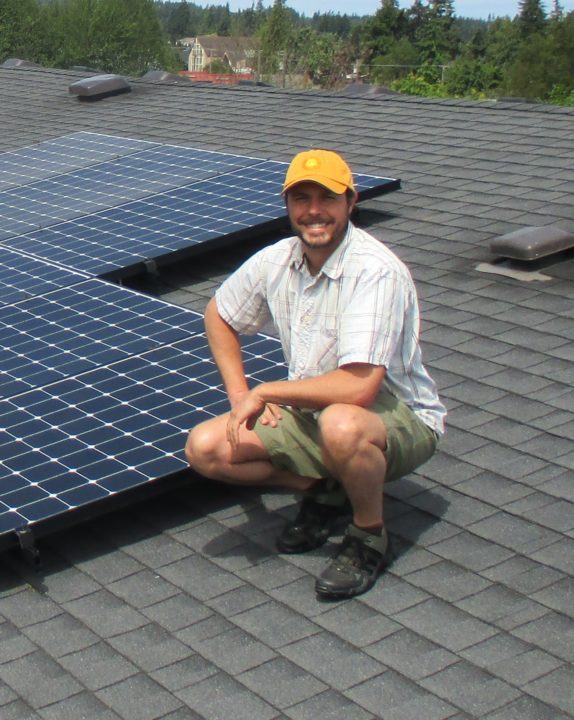
Typical Happy Solar Agent In the Field
by Andy Cochrane | Aug 2, 2017
The annual Washington solar production incentive payments are based on the fiscal year from July 1 – June 30, so everybody with a grid-tied pv system is about to read their meters for the 2016/2017 year.
You will get a letter from your utility containing a form similar to the one below. If you are a PSE customer, the form will be filled out for you. We are not certain what the Jefferson and Clallam PUD’s are planning this year. We have highlighted some of the important fields.
The main thing you want to bear in mind is to go read your production meter on June 30. Even if you are in PSE territory and they are going to read your meter and provide the information for you, we recommend reading your meter yourself at least annually. Then you will want to compare that figure with last year’s June 30 reading in order to get your annual production figure for this year. You will also be able to copy your DOR Tax Reporting Number from the top of last year’s form.
Unless you are among the minority of our clients who have the Made in Washington PV modules, you will use the field highlighted to report your total kilowatt-hours for the year. Although the base rate is stated as $0.15, all utilities in which we operate are or will be seriously pro-rating this base rate due to the fact that the applications are now exceeding the available incentive pool, of 0.5% of taxable utility revenues.
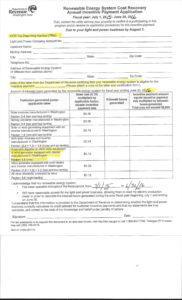
by Andy Cochrane | Jul 5, 2017
In the early morning Saturday July 1st, a couple of hours after passing the budget, both houses of the state legislature passed SB 5939, which will raise the caps on the currently over-subscribed solar production incentive, lowering incentive rates overall, but providing longer term certainty. There are several other aspects of this bill, which should be signed into law by Gov. Inslee soon. Until the Governor signs it, and even during the administrative rule-making process, anything can happen, however this looks as certain as things can get. Overall this is a major improvement over the existing program and great news for people who install grid-tied solar PV in the next couple of years. Lower rates but with a longer guaranteed result are helpful to everyone, however there are challenges in this new program.
The solar industry in Washington has been working with the legislature at least four years to implement many of these changes. A brief initial summary is in order:
- For new projects, incentive payments will be paid at a guaranteed rate for 8 years, rate determined by the date of commissioning as per the following table (Sec 5 (10))
- Sales tax exemption expires Sept 30, 2017 (Sec 15 3))
- Incentive cap per utility increases from 0.5% to 1.5% of the utility’s taxable power sales (Sec 4(2))
- Responsibility for administration of the program is being moved from Dept of Revenue to WSU Energy Extension (Sec 3 (9))
- People with existing systems may install additional systems and enroll them in the new program (Sec 6 (3)(b))
- People enrolled in the existing program will be able to re-enroll to have their rates stabilized at the 2015-2016 rates until June 30, 2020. (Sec 3 (10))
| Fiscal Year Certified |
Base Rate
(Residential, ie <12 KW) |
Base Rate
(Commercial, ie >12 KW) |
Made in WA Bonus |
| 2018 |
$0.16 |
$0.06 |
$0.05 |
| 2019 |
$0.14 |
$0.04 |
$0.04 |
| 2020 |
$0.12 |
$0.02 |
$0.03 |
| 2021 |
$0.10 |
$0.02 |
$0.02 |
One important take-away is that there is a golden moment right now. It appears people who install between now and Sept 30 will not pay sales tax, but will still get the benefit of the 8 year guaranteed rates. Meaning…if installing solar pv on your home or business has been something you have been considering, and that you would like to do “some day”, there has never been a better time than right now.
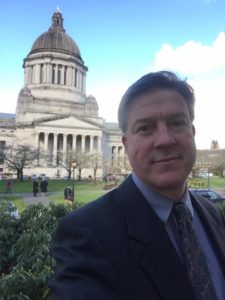
After meeting with representatives, Feb 2017
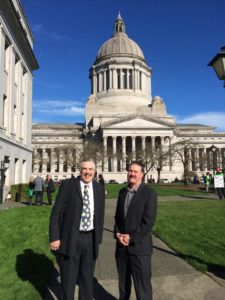
With Jeremy Smithson, March 2015, after testifying regarding net metering and renewable energy incentives’ effect on small businesses.
by Andy Cochrane | Jul 5, 2017
Our state’s Net Metering law was originally passed in 1998. All utilities in Washington State are required to allow their customers to install solar photovoltaic (or PV for short) renewable energy systems and provide “net metering” to their customers. Net metering allows you to use the solar electricity your system is generating and to sell any surplus to the electrical utility at the same retail rate they charge you for their electricity. Net metering regulations have dramatically improved the average person’s ability to create and use their own solar power. Here in the northwest our peak energy usage is typically during the wintertime when the days are shortest, while our peak sunny days and highest solar production occur in the summertime. With net metering, it doesn’t matter. Net metering allows us to earn credits on our monthly utility bills in the summertime with our grid tied solar PV system and use those credits in the fall and winter as the days get shorter and our energy needs start rising again. During the winter when your solar PV array isn’t producing as much power as your home or business requires, the grid provides steady, reliable power.
In this way, we are using the grid as a “virtual battery.” This virtual battery has many advantages over having an actual physical chemical battery in your home.
- It is infinitely sized, at least practically infinite relative to our 5-25 KW residential grid-tied pv system. Our solar electricity will never “fill” the grid, unlike an actual off-grid battery bank which may be at full charge early on a summer morning, not giving us anywhere to store our summer day’s energy unless we make certain to use the energy at the same rate at which it is being produced.
- It is 100% efficient. Energy stored in the form of a kwh (kilowatt-hour) credit on your meter is later used, and because there is no conversion from electrical to chemical energy and back, there is no loss due to inefficiency, which may be as low as 75% in some battery systems.
- We can seasonally store energy. There is no loss of energy over time when it is stored as a credit on your meter. So you can use summertime energy in the wintertime when you need it and your array is not producing as much power.
- You already pay a small monthly fee for the use of the grid. The grid construction and maintenance is a socialized cost shared by all utility customers, you will see you monthly service charge on your existing bill. This flat fee ranges from about $12 per month in progressive utilites, up to nearly $30 per month in utilities that keep kwh rates low by using high flat fees.
While in some states, there have been political battles over net metering, but there is no conversation along these lines in Olympia and it seems Net Metering is the law of the land for good.
Here is the underlying RCW 80.60: http://app.leg.wa.gov/rcw/default.aspx?cite=80.60
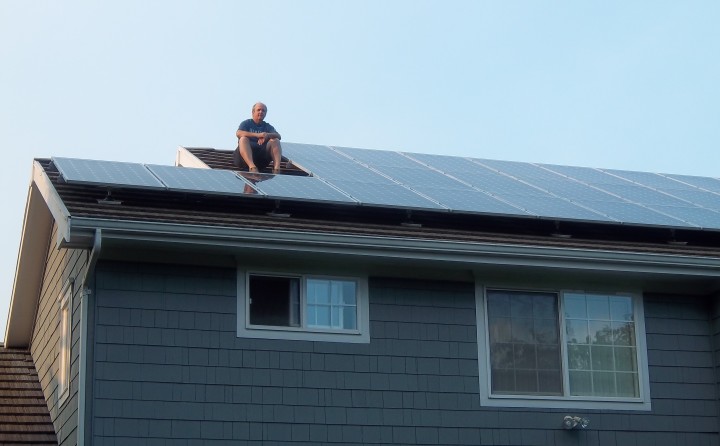
by Andy Cochrane | Jun 27, 2017
This is a good question, and one that is commonly asked.
Yes, solar power works just very well in our area of Washington State. Here on the north Olympic and Kitsap Peninsulas we average approximately 3.5 hours of full sun per day. That is about 70% of the solar resources of southern California. However, unlike southern California most of our sunshine arrives between March and September when our electricity needs are low, especially for homes designed to not require air conditioning. If your system is tied to the grid, your summertime excess electricity generation can go back onto the grid, and may be used by your neighbor or effectively by Californians during their peak energy usage. You will get a a credit for every kwh you put onto the grid, and you will use those credits later, perhaps that night, perhaps not until winter.
For another comparison, western Washington on average receives more yearly sunshine than does Germany on average. This is significant because for the 10 years 2005 – 2014, Germany led the world in the number of installed solar modules with over 50% of the world’s deployed solar modules during that time (China has now become the world’s top installer of solar pv.) If Germany can effectively utilize solar power so can western Washington.
We see an annual variation of up to 15% even among the same solar pv systems due to weather variation of one year to the next. The summers are predictably good, the winters are predictably winter, and we see the variation mostly in the spring – some springs are notably sunny and some are cloudier extensions of winter. Depending on exactly where you live on the Peninsula, if your home is unshaded, you can count of seeing 1000-1200 kwh/year-KW.
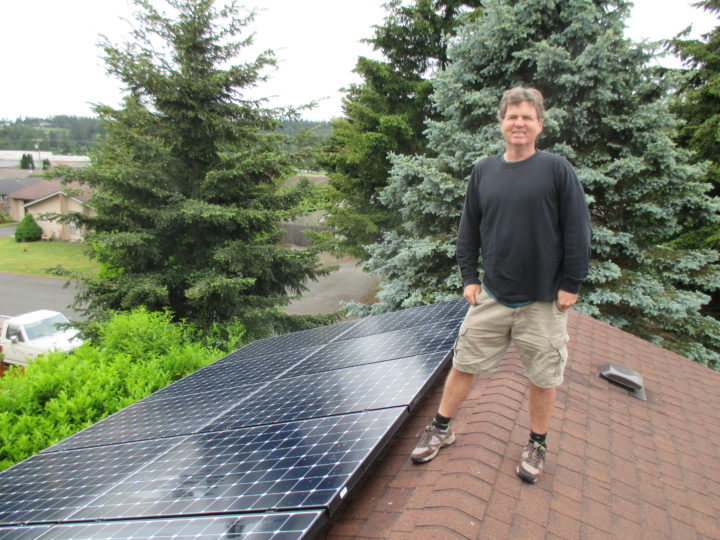
Murney Residence
by Andy Cochrane | Jun 13, 2017
David & Barbara Heid asked us to install a 12.4 KW Solar PV system on their new home. They felt compelled to provide the following review based on their experience so far.
—
Power Trip (PT) was instrumental in building our new “green” house. Several years ago PT was asked to survey our possible building site for potential solar energy capture. Their survey reported that the site had positive solar potential. That survey began our strong relationship with PT.
PT was with us from the beginning of our newhome. PT determined the compass orientation of the house foundation that would place the roof line for the greatest capture of solar energy. PT also designed the angle (slope) and size of the roof for placement of solar panels. PT also helped in our selection of the metal roof style that enhanced panel placement without having to penetrate the roof for panel anchorage.
Our “green” home is installed with a ductless heat pump for household heat, a ‘heat-pump’ hot water heater, and all lighting is LED. The house is insulated beyond county code requirements.
PT installed our solar panels on January 5, 2017. In addition to the panels, an EV (electric vehicle) charger station was installed. On April 28th , an all electric Chevrolet Bolt was purchased.
Today after 129 days since the installation of the solar panels, data collected shows that the ave daily energy use for the house is 32.87 kWh. So far, the ave daily Solar energy production is 32.07 kWh with a result of 97.57% of the daily household electrical use being supplied from Power Trip installed solar panels (32.07kWh/32.87kWh). The total household use of electricity includes the kWh used to charge the Bolt. The Bolt has been driven over 2000 miles since its purchase and it has been charged at our new home only.
Also, our PUD electric bills for March and April were only for the monthly $14.50 base fee that is charged to each electric bill. No charges were made for electricity since no electricity was delivered. In addition, the May PUD electric bill states that 396 kWh have been added to our banked usage balance.
We look forward to the days ahead when the ‘2017 spring rain season’ is replaced with some long days of sunshine and ‘banking’ energy for later winter days. Also with new batteries being developed, our future may include an ‘on site’ energy storage system.
Can we recommend Power Trip Energy for solar planning and installation? YOU BET!
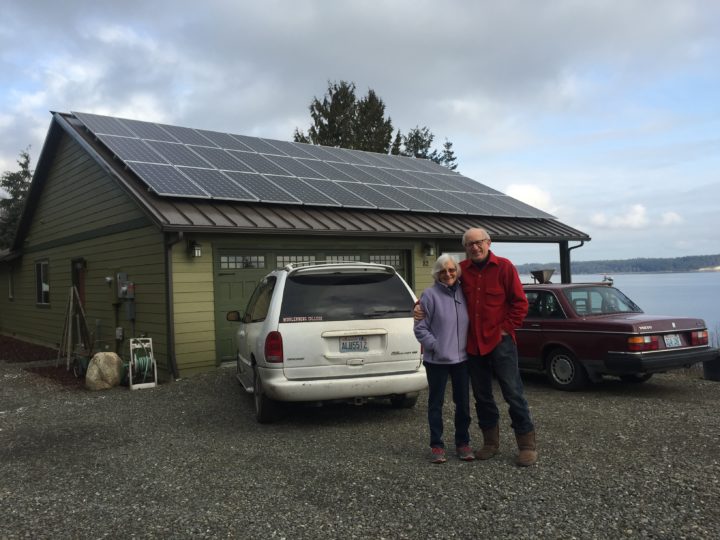
Heid Residence, 12.4 KW, Port Ludlow, Feb 2017
by Andy Cochrane | May 23, 2017
Puget Sound Energy (PSE), like all major utilities in Washington State, has long offered a Green Power program. This program allows you to enroll and pay an additional amount per kwh to get green energy. When we used to be PSE customers, we participated in the Green Power program in which we would pay a premium each month to make certain that what electricity we did buy from PSE (what we needed beyond what our solar pv produced), was sourced from clean energy sources. The main component in the Green Power program has been wind energy from a couple of large utility scale wind projects owned by PSE.
Now PSE is offering a solar specific green power program called Solar Choice. The Solar Choice program is similar to the existing Green Power program in that it offers customers the ability to pay a premium in order to make certain that PSE sources and allocates sufficient solar pv generated electricity to cover the amount you sign up to buy.
While this is very different from purchasing your own solar pv array for your own house, it is a good idea if you are a renter or have a shady roof and can’t install your own solar pv. The benefits are that you get the satisfaction of knowing there is some solar energy being produced somewhere with your name on those electrons, and you can participate or not as you choose. The more solar choices people have, the better.
If you own your house and have a sunny roof, its probably better to choose to make an upgrade to your house that will make clean power and decrease your home’s energy bills for decades.
https://pse.com/savingsandenergycenter/Renewables/Pages/default.aspx
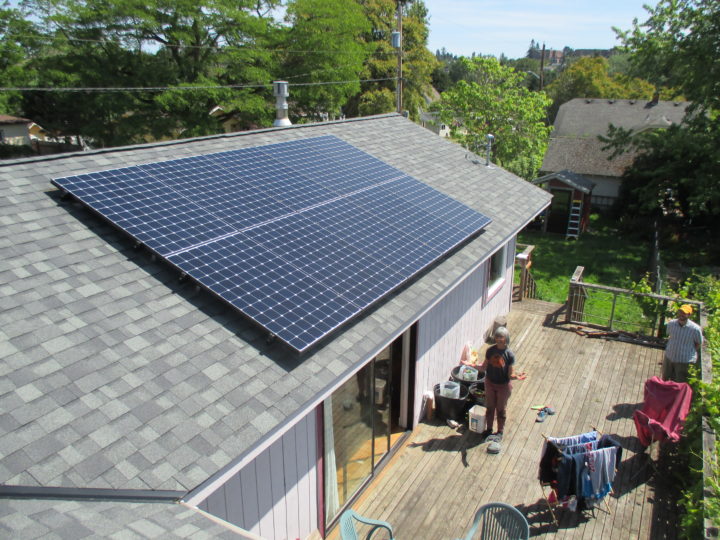
Palmer Residence, Dec 2016
by Andy Cochrane | May 15, 2017
The solar business is fun and dynamic. It feels great to be working in an industry which provides a long-term solutions for some of the problems inherent in the energy status quo, and because the majority of people consider themselves supporters of solar, we get a lot of interest and support even from people that are not our customers. While solar photovoltaic panels have been made continuously since the 1950’s using the basic same materials and techniques, the industry itself is more dynamic than the technology. Many business leaders (including us) see nothing but opportunity for growth, indeed every sunny rooftop I see is a place where I think solar pv should be installed. The barriers are not technological, they are economic and social barriers only.
We are a small company assessing the market to determine the best options for our clients. Based on our years of experience, we have become practical and skeptical of flashy marketing. This practicality often comes up when people inquire about new products, and lately it seems like Tesla is again the center of attention. An incredible company led by a charismatic genius CEO, they now have the largest market capitalization of any US car manufacturer, despite the fact that Tesla sold 80,000 cars in 2016, and Ford sold 6.7 million cars for example. Valuations are as much about stories as balance sheets, and Tesla’s leaders are master story tellers. They are also masters of shaping their own reality, as evidenced by the quality of the cars they manufacture dubbed “Car of the Century” by Car and Driver http://www.caranddriver.com/reviews/2015-tesla-model-s-70d-instrumented-test-review, and by the fact that they have installed the largest utility energy storage facilities in the world with their Li-ion batteries. http://blog.solarcity.com/island-in-the-sun/
Regarding the solar roofs, Tesla has announced they will begin taking orders in April, aiming to begin installations by the end of 2017. They are currently advertising for and hiring roofers, indicating initially at least they will begin as contractors with in-house installers, as Solar City (a national solar installer now owned by Tesla) has done. Of note, the company has a history of taking orders very early, and delaying delivery dates significantly. If you need a new roof now, or if you want to utilize the 30% federal tax credit currently in place, you probably shouldn’t wait for this product.
Eric Wesoff provides a survey of a couple of new solar roofs and several unsuccessful BIPV (Building Integrated solar PV, an industry term for solar roofs) ventures here: https://www.greentechmedia.com/articles/read/Tesla-Says-It-Will-Take-Orders-for-the-Solar-Roof-in-April
Will Tesla again succeed where others have failed? We are looking forward to seeing what they can accomplish, and how it will relate to the other options available at the time. In the meanwhile, we won’t be holding our breath.
Regardless of what the future may hold, what we have to offer right now is better than any time in the past, more watts per square foot at a lower price, with proven technology and 25 year warranties. We invite you to learn more at one of our upcoming events, we look forward to seeing you. https://powertripenergy.com/events/
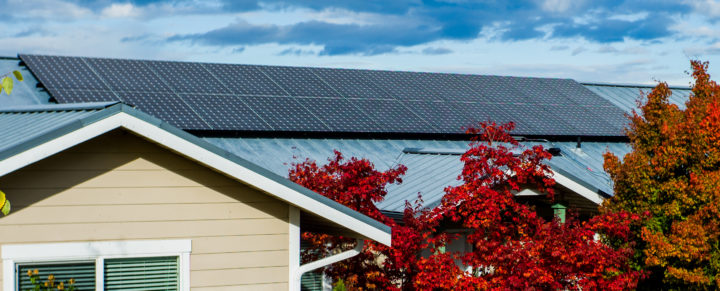
Meyer Residence, 7.6 KW (SunPower 345 watt modules) on the Clallam PUD grid in Sequim
by Andy Cochrane | Apr 11, 2017
